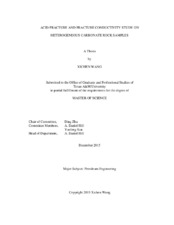| dc.description.abstract | Acid fracturing is a widely used stimulation technique for carbonate reservoirs, and more efficient both technically and economically compared with propped fracturing. However, the performance of acid fracturing is hard to predict, and the technique does not always provide sufficient improvement to the productivity. Furthermore, it is even more challenging to stimulate deep wells in heterogeneous reservoirs with high temperature and pressure environments. In this study, experiments were conducted on field cores to investigate the influence of rock lithology, permeability, porosity on fracture conductivities.
Five carbonate core samples from three different wells were tested. All samples are composed of limestone and dolomite with different compositions. The permeability varies within the range of 0.002 md to 0.006 md and the porosity ranges from 1.6% to 3.0%. To compare the results, unpropped and propped hydraulic fracture conductivity tests were also performed on all five core samples along with acid fracture conductivity tests. Experimental conditions, such as acid type, injection rate, contact time, system temperature, and leak-off acid volume were recorded during the acid etching tests. Additionally, the fracture surfaces of each sample were scanned before and after the acid treatment to calculate the total acid etched volume and to characterize the changes in surface profiles.
The results indicated that the formation characteristics had a significant influence
on the acid fracture conductivity. The sample with mainly dolomite was less reactive to acid and had less acid etching volume than the samples with mainly limestone. Furthermore, the heterogeneity of the sample rock had a direct impact on the roughness of the fracture surface, which also affected acid etching pattern, acid leak-of volume, and acid fracture conductivity results. | en |


